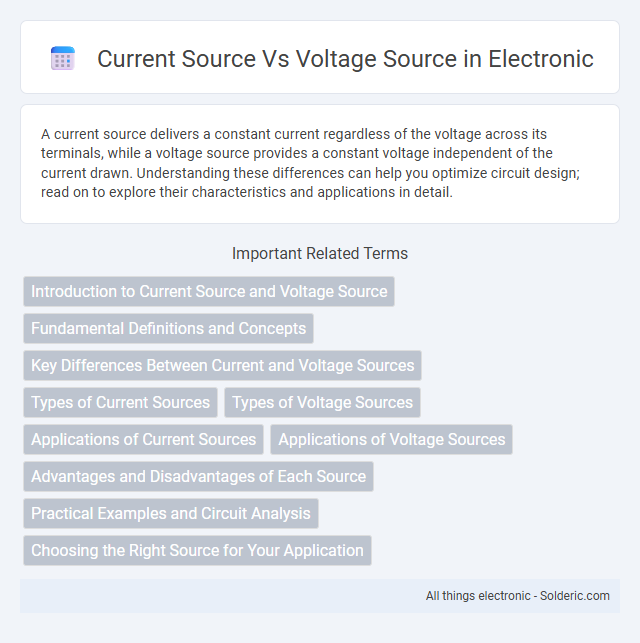A current source delivers a constant current regardless of the voltage across its terminals, while a voltage source provides a constant voltage independent of the current drawn. Understanding these differences can help you optimize circuit design; read on to explore their characteristics and applications in detail.
Comparison Table
| Aspect | Current Source | Voltage Source |
|---|---|---|
| Definition | Delivers constant current regardless of load resistance. | Delivers constant voltage regardless of load current. |
| Output Characteristic | Constant current output. | Constant voltage output. |
| Internal Impedance | High internal impedance (ideally infinite). | Low internal impedance (ideally zero). |
| Load Dependence | Current stable, voltage varies with load. | Voltage stable, current varies with load. |
| Symbol | Circle with arrow inside. | Circle with plus and minus signs. |
| Common Applications | LED drivers, current regulation circuits. | Power supplies, batteries. |
| Behavior in Open Circuit | Voltage can rise to high values, potentially damaging. | Voltage remains constant, current drops to zero. |
| Behavior in Short Circuit | Current remains constant, voltage drops. | Current can increase, potentially high. |
Introduction to Current Source and Voltage Source
A current source delivers a consistent current regardless of the voltage across its terminals, whereas a voltage source provides a constant voltage regardless of the current drawn. Current sources are ideal for applications requiring stable current flow, while voltage sources are fundamental in maintaining fixed voltage levels in circuits. Understanding the differences between these sources helps you design efficient and reliable electronic systems.
Fundamental Definitions and Concepts
A current source is an electronic device or circuit that delivers a constant current regardless of the voltage across its terminals, while a voltage source provides a constant voltage regardless of the current drawn from it. In practical terms, an ideal current source maintains a fixed current flow by adjusting its terminal voltage, whereas an ideal voltage source maintains a fixed terminal voltage by supplying the necessary current. Understanding these fundamental differences helps you design and analyze circuits more effectively, ensuring proper load behavior and power management.
Key Differences Between Current and Voltage Sources
Current sources deliver a constant current regardless of the voltage across their terminals, while voltage sources provide a constant voltage regardless of the current drawn. Voltage sources are modeled as ideal devices with zero internal resistance, whereas current sources have infinite internal resistance. The primary difference lies in their response to load changes: current sources maintain current steady, and voltage sources maintain voltage steady, influencing circuit design and analysis differently.
Types of Current Sources
Current sources are categorized primarily into ideal and practical types, with ideal current sources delivering constant current regardless of voltage changes, while practical current sources have limitations due to internal resistance. Types of current sources include independent current sources, which provide fixed current, and dependent current sources, whose output current depends on another circuit variable such as voltage or current elsewhere in the circuit. Specialized variations include transistor current sources used in analog circuits and programmable current sources utilized in testing and calibration.
Types of Voltage Sources
Voltage sources are categorized into independent and dependent types, each serving distinct roles in electronic circuits. Independent voltage sources provide a constant voltage regardless of the load current, commonly seen in batteries and power supplies. Dependent voltage sources, controlled by another circuit variable such as current or voltage, are essential in amplifiers and feedback circuits, highlighting the versatility in managing Your circuit's voltage requirements.
Applications of Current Sources
Current sources are widely used in driving LEDs, ensuring a stable current regardless of voltage fluctuations, which prevents damage and maintains consistent brightness. They are essential in analog circuits, such as biasing transistors in amplifiers, where constant current improves performance and linearity. Precision current sources are also critical in sensor excitation and calibration systems, providing accurate and stable currents for reliable measurements.
Applications of Voltage Sources
Voltage sources are widely used in powering electronic devices, providing a constant voltage supply essential for circuits like amplifiers, radios, and digital devices. They are crucial in applications such as battery chargers, where maintaining a stable voltage ensures safe and efficient charging. Your electronic project relies on voltage sources to deliver consistent power, ensuring reliable operation and performance.
Advantages and Disadvantages of Each Source
Current sources provide a constant current regardless of load resistance, making them ideal for applications requiring stable current flow, but they can suffer from voltage fluctuations that limit power delivery. Voltage sources deliver a constant voltage and can supply varying amounts of current depending on the load, offering versatility but potentially causing current fluctuations that may affect sensitive components. Understanding the trade-offs between current and voltage sources helps optimize your circuit design for reliability and performance.
Practical Examples and Circuit Analysis
Current sources, commonly used in LED drivers and biasing transistor circuits, provide a constant current regardless of voltage changes, ensuring stable operation in varying load conditions. Voltage sources, like batteries and power supplies, maintain a fixed voltage output, ideal for powering devices with predictable resistance, such as resistors or simple electronic gadgets. Understanding the differences in circuit analysis allows you to accurately model how components respond under realistic scenarios, optimizing design and troubleshooting efforts.
Choosing the Right Source for Your Application
Selecting between a current source and a voltage source depends on the specific requirements of your application, such as load characteristics and desired output stability. Current sources are optimal for driving constant current through components like LEDs or sensors, maintaining steady current regardless of load changes. Voltage sources are ideal for applications needing constant voltage supply, such as powering microcontrollers or circuits with variable loads, ensuring voltage remains stable despite fluctuations in current demand.
Current source vs Voltage source Infographic

 solderic.com
solderic.com